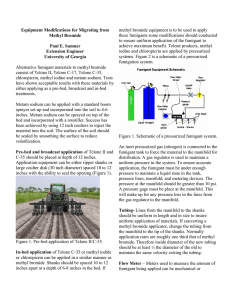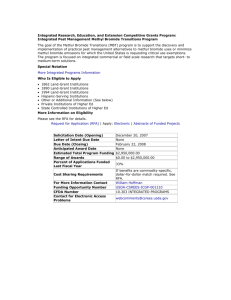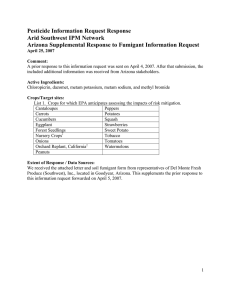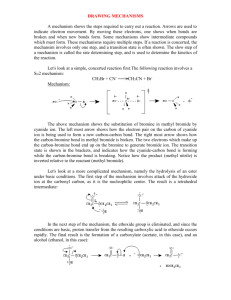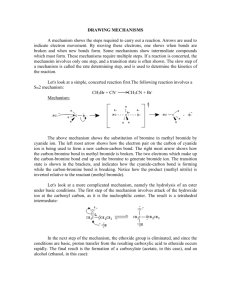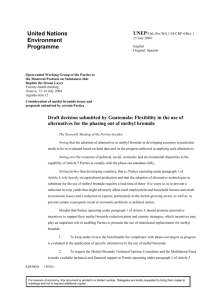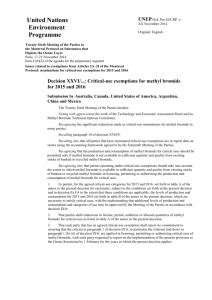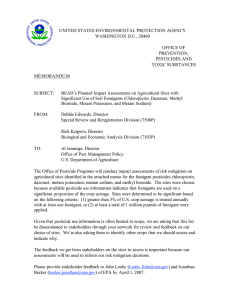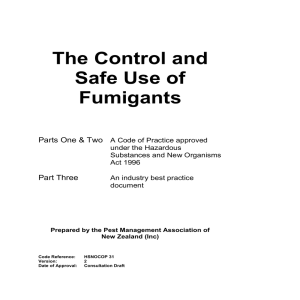EQUIPMENT MODIFICATIONS AND APPLICATION OF METHYL BROMIDE ALTERNATIVES Paul E. Sumner
advertisement
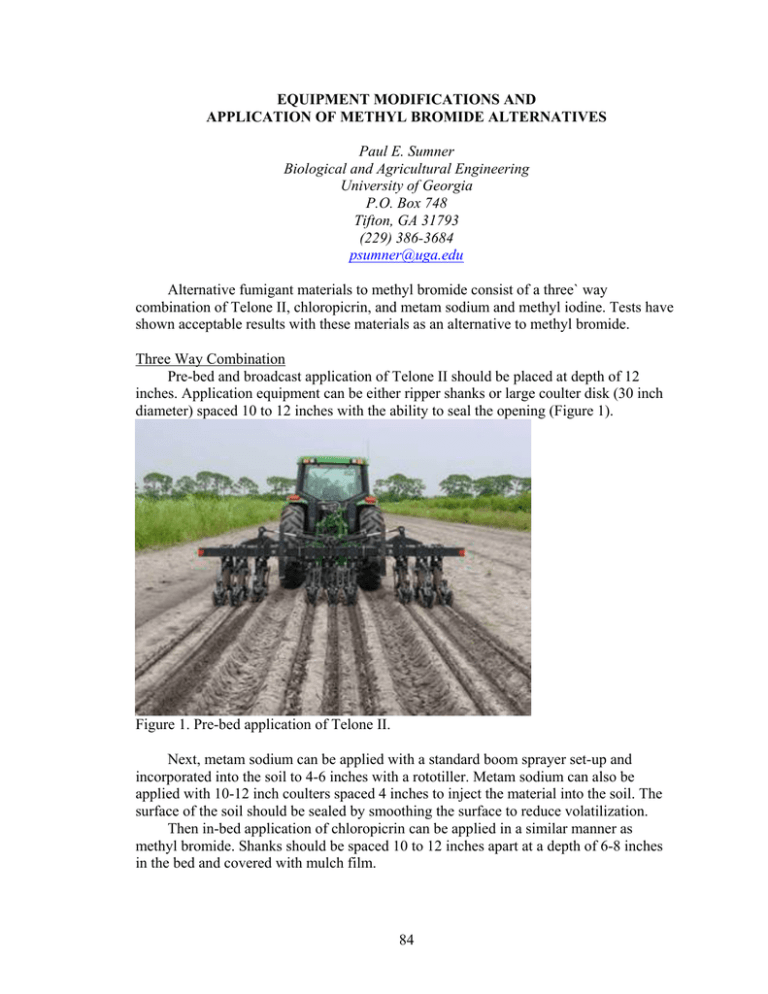
EQUIPMENT MODIFICATIONS AND APPLICATION OF METHYL BROMIDE ALTERNATIVES Paul E. Sumner Biological and Agricultural Engineering University of Georgia P.O. Box 748 Tifton, GA 31793 (229) 386-3684 psumner@uga.edu Alternative fumigant materials to methyl bromide consist of a three` way combination of Telone II, chloropicrin, and metam sodium and methyl iodine. Tests have shown acceptable results with these materials as an alternative to methyl bromide. Three Way Combination Pre-bed and broadcast application of Telone II should be placed at depth of 12 inches. Application equipment can be either ripper shanks or large coulter disk (30 inch diameter) spaced 10 to 12 inches with the ability to seal the opening (Figure 1). Figure 1. Pre-bed application of Telone II. Next, metam sodium can be applied with a standard boom sprayer set-up and incorporated into the soil to 4-6 inches with a rototiller. Metam sodium can also be applied with 10-12 inch coulters spaced 4 inches to inject the material into the soil. The surface of the soil should be sealed by smoothing the surface to reduce volatilization. Then in-bed application of chloropicrin can be applied in a similar manner as methyl bromide. Shanks should be spaced 10 to 12 inches apart at a depth of 6-8 inches in the bed and covered with mulch film. 84 To save a trip in the field metam sodium can be applied at the same time as the chloropicrin on a pre-formed bed. The equipment can be modified to have coulters located prior to the press pan in throat of bedder. Methyl Iodide Methyl iodide can be applied with methyl bromide applicators with minor modifications. Modifications If methyl bromide equipment is to be used to apply these fumigants some modifications should conducted to ensure uniform application of the fumigant to achieve maximum benefit. Telone II, methyl iodine and chloropicrin are applied by pressurized systems. Figure 2 is a schematic of a pressurized fumigation system. Figure 1. Schematic of a pressurized fumigant system. An inert pressurized gas (nitrogen) is connected to the fumigant tank to force the material to the manifold for distribution. A gas regulator is used to maintain a uniform pressure in the system. To ensure accurate application, the fumigant must be under enough pressure to maintain a liquid state in the tank, pressure lines, manifold, and metering devices. The pressure at the manifold should be greater than 10 psi. A pressure gage must be place at the manifold. This will make up for any pressure loss in the lines from the gas regulator to the manifold. Tubing lines from the manifold to the shanks should be uniform in length and sized to insure uniform application of materials. If converting a methyl bromide applicator, change the tubing from the manifold to the tip of the shanks. Normally application rates are roughly one third that of methyl bromide. Therefore the inside diameter of the new 85 tubing should be at least ½ the diameter of the old to maintain the same velocity exiting the tubing. The flow meter used to measure the amount of fumigant being applied can be mechanical or electronic. Mechanical meters normally give an indication of percent of maximum flow through the meter. Electronic meters can measure fumigant flow, total applied, acres, and etc. Both systems require a factor to convert from water to the particular fumigant. Table 2 list properties of common fumigants. Table 2. Properties of various fumigants. Material MB 98% MB 67% Density Specific Conversion (lbs/gal) Gravity Factor 14.4 1.732 0.760 14.2 1.702 0.763 Chloropicrin 14.1 1.692 0.769 Telone II 10.2 1.218 0.906 Telone C-17 10.6 1.270 0.887 Telone C-35 11.2 1.340 0.864 Methyl Iodine 98% Methyl Iodine 50% Water 19.0 2.277 0.663 16.75 2.010 0.705 8.345 1.000 1.000 Some materials may have a violent reaction when coming in contact with a particular soil fumigant. Read the label to ensure the construction of the application equipment being used is compatible. Listed are materials compatible and not compatible with fumigants. • COMPATIBLE: HD polyethylene, nylon, Teflon, Viton, stainless steel, and cross-linked polyethylene. • NOT COMPATIBLE: polypropylene, rubber, plastic, aluminum, magnesium, zinc, cadmium, galvanized steel, fiberglass, EPDM, Nuna-N, neoprene and PVC. • Mild steel, iron, brass and copper are not compatible or corrosive with chloropicrin and metam sodium. Read the label. Conclusion Methyl bromide equipment can be used to apply the alternative fumigants such as chloropicrin and methyl iodine. Telone II and metam sodium applicators are readily available and can be used with little or no modifications. All fumigants should be applied according to the label. Make sure that the proper safety equipment is used such as coveralls, respirator, gloves and etc. 86
